Monthly Updates on Recent Books in the History of Christianity
To raise awareness of recent books in the history of Christianity, the editorial staff of Church History: Studies in Christianity and Culture highlights each month a list of 10-15 books in diverse periods and geographical regions that we hope will be of interest to our members. We include here below the 24th monthly list, chosen by our staff, with excerpts from the publishers’ blurbs.

David W. Bebbington, The Gospel in Latin America: Historical Studies in Evangelicalism and the Global South. 2022
The shift of the center of gravity in world Christianity from the Global North to the Global South was arguably the most important development in the faith during the twentieth century. One of the most salient dimensions within that broader evolution was the rise of evangelical Protestantism in Latin America, once a Roman Catholic stronghold. In the early twenty-first century a high percentage of Latin America was Pentecostal, but there had also been significant growth of other denominations, including Methodists and Baptists. By 2019 an estimated 19 percent of the population of Latin America identified as evangelicals.
The Gospel in Latin America includes a broad range of studies in the history of Latin American evangelicalism from experts in the field. Five chapters address issues affecting the whole of Latin America, including the relationship of evangelicalism to demography and the rise of the political ideology of Dominionism. A further five concentrate on developments in specific nations such as evangelical intellectual life in Brazil and the forging of evangelical identity in Argentina. Pentecostalism is included, but space is given to the full range of religious groups. Politics is not omitted, but the volume’s main concern is the core religious priorities of the movement associated with the spread of the gospel.
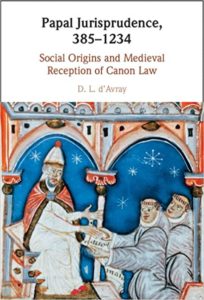
D. L. d’Avray, Papal Jurisprudence, 385-1234: Social Origins and Medieval Reception of Canon Law. 2022
Why did bishops turn to the papacy for advice in late Antiquity? And what does the reception of these decretals reveal about the legal and religious culture of the mid-thirteenth century? This interpretative volume seeks to explain the first decretal age of late antiquity, placing the increased demand for papal jurisprudence – long before it exerted its influence through religious fear – within its social broad context. D. L. d'Avray then traces the reception of this jurisprudence through to the mid-thirteenth century, and the post-Gratian decretal age. Along the way he explores the role of Charlemagne and 'Pseudo-Isidore', which included many genuine early decretals alongside forged ones. Similarities between the Latin world c. 400 and c. 1200 thus help explain parallels between the two decretal ages. This book also analyses decretals from both ages in chapters on pagan marriages, clerics in minor orders, and episcopal elections. For both ages the relation between canon law and other religious genres is elucidated, demonstrating many fascinating parallels and connections.
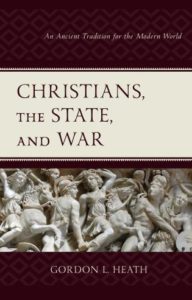
Gordon L. Heath, Christians, the State, and War: An Ancient Tradition for the Modern World. 2022
In Christians, the State, and War: An Ancient Tradition for the Modern World, Gordon Heath argues that the pre-Constantinian Christian testimony regarding the state’s just use of violence was remarkably uniform and that it was arguably a catholic, or universal, tradition. More specifically, that tradition had five interrelated and intertwined constitutive areas of consensus that can best be understood as parts of one collective tradition. Heath further argues that those five related areas of an early church tradition shaped all subsequent theological developments on views of the state, its use of violence, and the conditions of Christian participation in said violence. Whereas the sorry and sordid instances in the church’s history related to violence were times when the church drifted from those convictions of consensus, the cases when Christians had a more stellar record of responding to the horrors of the world were times when they lived up to them. Consequently, the way forward today is for Christians to forgo beginning with the just war-pacifist debate, and, instead, to begin by letting their views on war and peace be shaped by that ancient tradition.

David Kim-Cragg, Water from Dragon’s Well: The History of a Korean-Canadian Church Relationship. 2022
McGill-Queen’s University Press
A Canadian-built mission house in the heart of Seoul became the heart of the emerging South Korean democratization movement, while a Korean minister rose to serve as the spiritual leader of Canada’s largest Protestant denomination. The century-long Korean-Canadian church relationship has had a lasting influence on Korean society and on the culture and mission of the United Church of Canada, helping to crack the colonial foundations of Canadian Protestantism.
Water from Dragon’s Well explores the connection between the Korean Christian community and the Canadian church and its missionaries from the 1890s to the present. Upon the arrival of Canadian missionaries, Korean Christian churches were already voicing nationalist aspirations; by the mid-twentieth century, they were demanding independence from Canadian missionary oversight and were participating in a wider democratic movement within South Korea. David Kim-Cragg traces indigenous churches’ resistance to decades of missionary paternalism and the ways they channeled their religious and political energies. Accepting the criticism of its hosts, the United Church of Canada helped build an independent Korean Christian church and, in 1974, ended its Korean mission. This shift in the Canadian missionaries’ colonial attitudes also contributed to the transformation of the United Church of Canada back home. With the help of Korean leadership in Canada, the church reconstructed its vision of non-Western Christianity and, in a watershed moment, established an ethnic ministry council.
Situated within ongoing conversations about the legacies of colonization and racism, Water from Dragon’s Well shows how wellsprings of religion and politics from Korea challenged and transformed white Canadian attitudes and institutions.

Meg Leja, Embodying the Soul: Medicine and Religion in Carolingian Europe. 2022
University of Pennsylvania Press
Embodying the Soul explores the possibilities and limitations of human intervention in the body's health across the ninth-century Carolingian Empire. Early medieval medicine has long been cast as a superstitious, degraded remnant of a vigorous, rational Greco-Roman tradition. Against such assumptions, Meg Leja argues that Carolingian scholars engaged in an active debate regarding the value of Hippocratic knowledge, a debate framed by the efforts to define Christian orthodoxy that were central to the reforms of Charlemagne and his successors.
From a subject with pagan origins that had suspicious links with magic, medical knowledge gradually came to be classified as a sacred art. This development coincided with an intensifying belief that body and soul, the two components of individual identity, cultivated virtue not by waging combat against one another but by working together harmoniously. The book demonstrates that new discussions regarding the legitimacy of medical learning and the merits of good health encouraged a style of self-governance that left an enduring mark on medieval conceptions of individual responsibility. The chapters tackle questions about the soul's material occupation of the body, the spiritual meaning of illness, and the difficulty of diagnosing the ills of the internal bodily cavity.
Combating the silence on "dark-age" medicine, Embodying the Soul uncovers new understandings of the physician, the popularity of preventative regimens, and the theological importance attached to dietary regulation and bloodletting. In presenting a cultural history of the body, the book considers a broad range of evidence: theological and pastoral treatises, monastic rules, court poetry, capitularies, hagiographies, biographies, and biblical exegesis. Most important, it offers a dynamic reinterpretation of the large numbers of medical manuscripts that survive from the ninth century but have rarely been the focus of historical study.
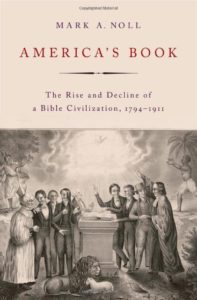
Mark Noll, America's Book: The Rise and Decline of a Bible Civilization, 1794-1911. 2022
America's Book shows how the Bible decisively shaped American national history even as that history influenced the use of Scripture. It explores the rise of a strongly Protestant Bible civilization in the early United States that was then fractured by debates over slavery, contested by growing numbers of non-Protestant Americans (Catholics, Jews, agnostics), and torn apart by the Civil War.
This first comprehensive history of the Bible in America explains why Tom Paine's anti-biblical tract The Age of Reason (1794) precipitated such dramatic effects, how innovations in printing by the American Bible Society created the nation's publishing industry, why Nat Turner's slave rebellion of 1831 and the bitter election of 1844 marked turning points in the nation's engagement with Scripture, and why Theodore Roosevelt and Woodrow Wilson were so eager to commemorate the 300th anniversary of the King James Version of the Bible.
Noll's magisterial work highlights not only the centrality of the Bible for the nation's most influential religious figures (Methodist Francis Asbury, Richard Allen of the African Methodist Episcopal Church, Catholic Bishop Francis Kenrick, Jewish scholar Solomon Schechter, agnostic Robert Ingersoll), but also why it was important for presidents like Abraham Lincoln; notable American women like Harriet Beecher Stowe, Elizabeth Cady Stanton, and Frances Willard; dedicated campaigners for civil rights like Frederick Douglass and Francis Grimké; lesser-known figures like Black authors Maria Stewart and Harriet Jacobs; and a host of others of high estate and low. The book also illustrates how the more religiously plural period from Reconstruction to the early twentieth century saw Scripture become a much more fragmented, though still significant, force in American culture, particularly as a source of hope and moral authority for Americans on both sides of the battle over white supremacy- both for those hoping to fight it, and for others seeking to justify it.
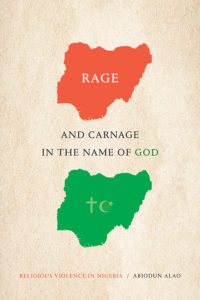
Abiodun Alao, Rage and Carnage in the Name of God: Religious Violence in Nigeria. 2022
In Rage and Carnage in the Name of God, Abiodun Alao examines the emergence of a culture of religious violence in postindependence Nigeria, where Christianity, Islam, and traditional religions have all been associated with violence. He investigates the root causes and historical evolution of Nigeria’s religious violence, locating it in the forced coming together of disparate ethnic groups under colonial rule, which planted the seeds of discord that religion, elites, and domestic politics exploit. Alao discusses the histories of Christianity, Islam, and traditional religions in the territory that became Nigeria, the effects of colonization on the role of religion, the development of Islamic radicalization and its relation to Christian violence, the activities of Boko Haram, and how religious violence intermixes with politics and governance. In so doing, he uses religious violence as a way to more fully understand intergroup relations in contemporary Nigeria.
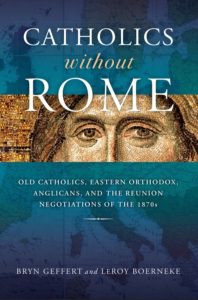
Bryn Geffert and Leroy Boerneke, Catholics without Rome: Old Catholics, Eastern Orthodox, Anglicans, and the Reunion Negotiations of the 1870s. 2022
University of Notre Dame Press
Catholics without Rome examines the dawn of the modern, ecumenical age, when “Old Catholics,” unable to abide Rome’s new doctrine of papal infallibility, sought unity with other “catholics” in the Anglican and Eastern Orthodox churches.
In 1870, the First Vatican Council formally embraced and defined the dogma of papal infallibility. A small and vocal minority, comprised in large part of theologians from Germany and Switzerland, judged it uncatholic and unconscionable, and they abandoned the Roman Catholic Church, calling themselves “Old Catholics.” This study examines the Old Catholic Church’s efforts to create a new ecclesiastical structure, separate from Rome, while simultaneously seeking unity with other Christian confessions. Many who joined the Old Catholic movement had long argued for interconfessional dialogue, contemplating the possibility of uniting with Anglicans and the Eastern Orthodox. The reunion negotiations initiated by Old Catholics marked the beginning of the ecumenical age that continued well into the twentieth century. Bryn Geffert and LeRoy Boerneke focus on the Bonn Reunion Conferences of 1874 and 1875, including the complex run-up to those meetings and the events that transpired thereafter. Geffert and Boerneke masterfully situate the theological conversation in its wider historical and political context, including the religious leaders involved with the conferences, such as Döllinger, Newman, Pusey, Liddon, Wordsworth, Ianyshev, Alekseev, and Bolotov, among others. The book demonstrates that the Bonn Conferences and the Old Catholic movement, though unsuccessful in their day, broke important theological ground still relevant to contemporary interchurch and ecumenical affairs. Catholics without Rome makes an original contribution to the study of ecumenism, the history of Christian doctrine, modern church history, and the political science of confessional fellowships. The book will interest students and scholars of Christian theology and history, and general readers in Anglican and Eastern Orthodox churches interested in the history of their respective confessions.

Ronald Hutton, Queens of the Wild: Pagan Goddesses in Christian Europe: An Investigation. 2022
In this riveting account, renowned scholar Ronald Hutton explores the history of deity-like figures in Christian Europe. Drawing on anthropology, archaeology, literature, and history, Hutton shows how hags, witches, the fairy queen, and the Green Man all came to be, and how they changed over the centuries.
Looking closely at four main figures—Mother Earth, the Fairy Queen, the Mistress of the Night, and the Old Woman of Gaelic tradition—Hutton challenges decades of debate around the female figures who have long been thought versions of pre-Christian goddesses. He makes the compelling case that these goddess figures found in the European imagination did not descend from the pre-Christian ancient world, yet have nothing Christian about them. It was in fact nineteenth-century scholars who attempted to establish the narrative of pagan survival that persists today.
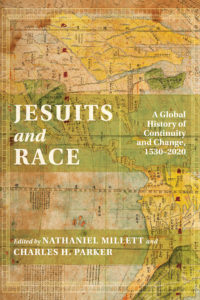
Nathaniel Millett and Charles H. Parker, eds. Jesuits and Race: A Global History of Continuity and Change, 1530-2020. 2022
University of New Mexico Press
Jesuits and Race examines the role that the Society of Jesus played in shaping Western understandings about race and explores the impact the Order had on the lives and societies of non-European peoples throughout history. Jesuits provide an unusual, if not unique, lens through which to view the topic of race given the global nature of the Society of Jesus and the priests' interest in humanity, salvation, conversion, science, and nature. Jesuits' global presence in missions, imperial expansion, and education lends insight into the differences in patterns of estrangement and assimilation, as well as enfranchisement and coercion, with people from Africa, Asia, and the Americas. The essays in this collection bring together case studies from around the world as a first step toward a comparative analysis of Jesuit engagement with racialized difference. The authors hone in on labor practices, social structures, and religious agendas at salient moments during the long span of Jesuit history in this fascinating volume.
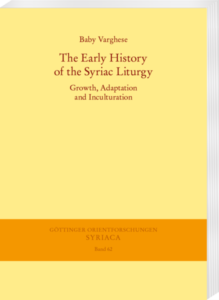
Baby Varghese, The Early History of the Syriac Liturgy: Growth, Adaptation and Inculturation. 2021
The present study is an overview of the general development of the Syriac liturgical traditions until the end of the 13th century. It traces some of the aspects of the encounter between Syriac Christianity and its surrounding cultural milieu. Literary genres and styles from the Early Jewish, Mesopotamian, Syro-Hellenistic and Arabic cultures were adapted in a process of encounter and inculturation. Along with Judaism, Mesopotamian pre-Christian and non-Christian cultures provided poetry, music and kinetic arts (gestures, movements and processions). The demonstrative piety of Antioch and Edessa has left traces of influence on the early Syriac liturgy. A few pagan and agrarian festivals were adapted, giving a Christian meaning. Throughout its history, Syriac liturgy is characterized by adaptability which is particularly evident in the history of the East Syriac Church in Central Asia and China where the liturgy was adapted to the culture of the nomadic tribes, introducing some unique para-liturgical practices.
Finally, for staying up-to-date on the latest titles in all fields, we recommend regularly perusing New Books Network and its "New Books in Christian Studies” page. These pages are updated regularly.
